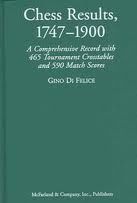Chess Results 1747-1900
Gino Di Felice

The first thing to say about Chess Results by Gino Di Felice is that if you have any interest in chess history before 1900, you must have this book. This compendium of tournament crosstables and match scores is the most complete available with 465 of the former and 590 of the latter. Previous to this, researchers had to rely on the works of P. Feenstra Kuiper and Jeremy Gaige, both of which have long been out of print. A complete collection of Gaige, running four volumes, would set you back between $150 and $200 in the secondhand market, though it would go up until 1930.
This is not a book for those who are looking to improve their game or even for those who want to play over games. Instead, this is a tremendous tool for those who like to do research. One innovation, that wasnt available in Gaiges books, and is most welcome, is the index of players in the back. At just a glance you can quickly have a record of what tournaments a player competed in instead of going page by page through the book.
Though Chess Results covers the period 1747-1900, tournament play didnt start until London 1851. Going through this work, one cant help but be struck by the fact that most tournaments played in the last fifty years of the 19th Century were contested in just three countries: England, Germany and the United States. This book is particularly good at chronicling the chess activities of Philadelphia and New York. How many people remember that Skaneateles, a village located in the Finger Lakes area of New York State, was once a major for center for chess activity, hosting several New York State Association events?
While I like Chess Results, theres one thing that I really appreciated in Gaiges books and didnt find here, namely giving sources for the match or tournament right next to the crosstable or result. This book, of course, like all McFarland works, has an extensive bibliography, but there is no way to know what the primary source was for a respective event. The author pays homage to the pioneering publications of P. Feenstra Kuiper and Jeremy Gaige, but curiously doesnt acknowledge any of the tremendous work done in the past four decades by Gaige and others. I am not knowledgeable enough to notice if any noteworthy events are missing from this book that are in fact available. It does make me wonder though not to see any mention of Gaige, Edward Winter, the late Ken Whyld, the John G. White Collection of the Cleveland Public Library, The Royal Dutch Library at the Hague, etc. in a list of acknowledgments.
All this said, Chess Results, 1747-1900 is a handsomely produced and fairly priced book that will serve as a standard reference for scholars for years to come.
